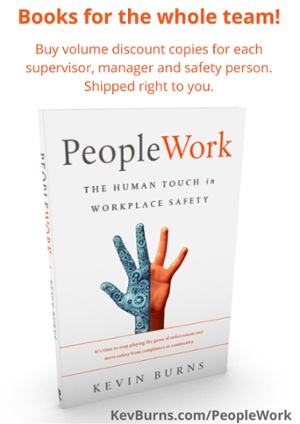You need to connect with employees in driving the things that are important to them.
You feel like you’re saying the right things in safety. Some days your safety performance is great. Other days, you wonder if your team was listening at all. And it frustrates you that just when you seem to be making steps forward, a dumb little incident shows up.
This is where you can change it up.
You need a safety message that resonates, at the right time, saying the right thing so that every employee is working toward common goals in safety. And the goals are not numbers. Stop pitching numbers to your people. Numbers don’t inspire better performance.
Ever see someone’s performance improve because the corporate TRIF rate target was 0.3 lower? Going over numbers don’t inspire anyone to want to care more about their fellow team members or to be more courteous towards them. Number mean little to employees. The numbers are for you: to track, to follow, to assess and to set your personal or departmental targets.
Numbers don't inspire.
Now, if you want their improved performance, you’ve got to win over their hearts and minds. You need to connect with employees in driving the things that are important to them. So far, what they’ve been hearing is what is important to you or the company. But not what is important to them.
Thinking that the Ten Most Dangerous Hazards, or the Eight Behaviours of Safety Performers, or the Thirteen Elements of Safe Work are important to them is out of touch. Articles, books and ideals that are important to you are likely not important to them. What’s important to them is what they get out of the deal: how safety improves their life, their results, and their pay-off (and people do with vigour anything that provides them with some sort of benefit).
Are you undermining your own message?
Don’t even think that celebrating going home safe is important to your people. It isn’t. Because that’s what you’re supposed to do, by law. You’re not allowed to do less than go home safe. So, the idea that going home safe is some sort of accomplishment is also out of touch. Your people show up at work expecting that their employer will ensure that they go home safe. Stop celebrating like going home safe is a big surprise. Like it’s not normal or that you have to work extra-hard to expect the minimum.
And please stop talking about compliance of rules and procedures. Rules and procedures don’t inspire better performance, or a willingness to look out for each other. We don’t need any more people talking to rules and process and procedure. We don’t need more people regurgitating what your people have already been trained on. Repeating it (like they didn’t get it at training) makes them feel stupid and makes you seem out of touch.
Here's what's needed.
What the world needs more of are more leaders (not managers) ready to lead others in growing a safety mindset where we include safety as a natural part of how we live life. We need more people who understand what leadership means to inspire employees to want to perform better, to choose better ways to do it and to look out for each other better.
 Ask yourself if you know what the one thing is that you want your people to do differently, or better, or more of, or less of? Don’t say safety. If you say safety, you’re out of touch.
Ask yourself if you know what the one thing is that you want your people to do differently, or better, or more of, or less of? Don’t say safety. If you say safety, you’re out of touch.
Focus on one or two ideas. Concentrate on the one or two things that you would like your people to get much better at, or do more of, or less of. Then, focus their attention on accomplishing that. And stop harping on rules. Unless that’s all you’ve got. Then you really are out of touch.
Leaders who can find the things that really matter to their people are already ahead of everyone else in building a really engaged team of safety performers. Safety is about people: engaging them, including them and valuing them.
--
Learn more strategies to create a high-participation safety culture. Put Kevin Burns' expertise to work in your organization. Kevin Burns is the creator of the M4 Method™ and the 90-Day Safety Accelerator program. He is the author of PeopleWork: The Human Touch in Workplace Safety.
Get details and more information http://www.kevburns.com/contact


